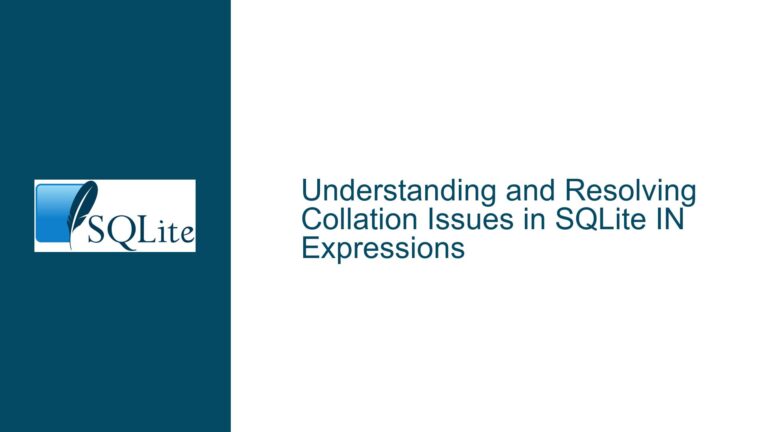Handling Zero-Width Joiner (U+200D) in SQLite String Comparisons and Replacements
Zero-Width Joiner (U+200D) in Unicode Strings and Its Impact on SQLite Queries
The Zero-Width Joiner (ZWJ), represented by the Unicode codepoint U+200D, is a non-printing character used in text rendering to indicate that adjacent characters should be joined together in a specific way. This character is commonly used in scripts like Devanagari (used for Hindi, Sanskrit, and other Indian languages) and emoji sequences to create ligatures or combined glyphs. In SQLite, the presence of ZWJ in strings can lead to unexpected behavior, especially when performing string comparisons, replacements, or substring searches. This issue arises because ZWJ is invisible and does not occupy any visual space, making it easy to overlook during data processing.
When dealing with Indian texts or other scripts that use ZWJ, developers may encounter situations where strings that appear identical visually do not match in SQLite queries. For example, the string "अमिताभ बच्चन" (Amitabh Bachchan) might be stored in two different ways: one with a ZWJ (e.g., "अमिताभ बच्चन") and one without. While these strings look the same when displayed, they are not binary-equivalent due to the presence of U+200D. This discrepancy can cause issues in applications that rely on exact string matching, such as search functionalities or data deduplication.
The challenge is further compounded when the ZWJ is represented as a literal Unicode entity (e.g., "u200d") in the input data. In such cases, the ZWJ is not interpreted as a single character but as a sequence of ASCII characters (‘u’, ‘2’, ‘0’, ‘0’, ‘d’). This representation requires conversion to the actual Unicode character (U+200D) before performing string operations. Without this conversion, SQLite’s string functions like replace() or substr() will not behave as expected, leading to incorrect results.
Interrupted String Processing Due to Misinterpreted Zero-Width Joiner (U+200D)
The root cause of issues involving the Zero-Width Joiner (U+200D) in SQLite queries lies in the misinterpretation or improper handling of this character during data ingestion, processing, or comparison. Below are the primary factors contributing to these issues:
Literal Unicode Entity Representation: When the ZWJ is represented as a literal string "u200d" instead of the actual Unicode character U+200D, SQLite treats it as a sequence of ASCII characters. This misinterpretation prevents SQLite from recognizing the ZWJ as a single character, leading to failed string matches or incorrect replacements. For example, the string "अमिताभ बच्u200dचन" will not match "अमिताभ बच्चन" because "u200d" is not equivalent to U+200D.
Inconsistent Data Sources: Data sources may inconsistently include or exclude ZWJ characters, especially when the data is processed by different systems or tools. For instance, one system might correctly handle ZWJ and store it as U+200D, while another system might strip it out or replace it with a space. This inconsistency results in non-matching strings even when the content is semantically identical.
Lack of Canonicalization: Unicode strings can have multiple representations for the same visual output. For example, the character "é" can be represented as a single codepoint (U+00E9) or as a combination of two codepoints (U+0065 for ‘e’ and U+0301 for the acute accent). Similarly, strings containing ZWJ may have alternative representations that are not binary-equivalent. Without canonicalization, SQLite queries may fail to match strings that are visually identical but differ in their underlying Unicode representation.
Improper Use of SQLite String Functions: SQLite’s built-in string functions, such as
replace()andsubstr(), operate on binary representations of strings. If the ZWJ is not correctly interpreted as a single character, these functions will not produce the desired results. For example, attempting to replace "u200d" with an empty string will not remove the ZWJ if it is stored as U+200D.Encoding Mismatches: SQLite assumes that text data is encoded in UTF-8 by default. If the input data is encoded in a different format (e.g., UTF-16 or ISO-8859-1), the ZWJ character may not be correctly interpreted. This encoding mismatch can lead to corrupted data or failed string operations.
Correcting Zero-Width Joiner (U+200D) Handling with SQLite Functions and Best Practices
To address issues related to the Zero-Width Joiner (U+200D) in SQLite, developers can employ a combination of SQLite functions, data preprocessing techniques, and best practices. Below are detailed steps and solutions to ensure proper handling of ZWJ in SQLite queries:
Convert Literal Unicode Entities to Actual Characters: If the input data contains literal Unicode entities like "u200d", use SQLite’s
replace()andchar()functions to convert them to the actual Unicode character. For example:SELECT replace('अमिताभ बच्u200dचन', 'u200d', char(0x200D));This query replaces the literal string "u200d" with the ZWJ character (U+200D), ensuring that the string is correctly interpreted.
Normalize Unicode Strings: Use Unicode normalization to convert strings to a canonical form before performing comparisons or replacements. SQLite does not have built-in support for Unicode normalization, but this can be achieved using external tools or libraries. For example, the
unicodedatamodule in Python can normalize strings to NFC (Normalization Form C) or NFD (Normalization Form D):import unicodedata normalized_string = unicodedata.normalize('NFC', input_string)After normalization, store the strings in SQLite to ensure consistent representation.
Ensure Consistent Data Sources: Verify that all data sources handle ZWJ consistently. If possible, preprocess the data to remove or standardize ZWJ characters before ingesting it into SQLite. This step reduces the likelihood of mismatched strings due to inconsistent ZWJ handling.
Use Binary Collation for Exact Matches: When performing exact string comparisons, use SQLite’s binary collation to ensure that strings are compared based on their binary representation. For example:
SELECT * FROM table WHERE column = 'अमिताभ बच्चन' COLLATE BINARY;This approach ensures that strings containing ZWJ are compared accurately.
Handle Encoding Mismatches: Ensure that all text data is encoded in UTF-8 before storing it in SQLite. Use tools or scripts to convert data from other encodings to UTF-8, preserving the ZWJ character. For example, the
iconvutility can convert text files to UTF-8:iconv -f ISO-8859-1 -t UTF-8 input.txt -o output.txtImplement Data Validation: Add validation checks to detect and correct ZWJ-related issues during data ingestion. For example, use regular expressions to identify literal Unicode entities like "u200d" and replace them with the actual character:
UPDATE table SET column = replace(column, 'u200d', char(0x200D));Document Data Processing Rules: Clearly document the rules for handling ZWJ and other special characters in your data processing pipeline. This documentation ensures that all team members follow the same guidelines, reducing the risk of inconsistencies.
By following these steps, developers can effectively handle the Zero-Width Joiner (U+200D) in SQLite, ensuring accurate string comparisons, replacements, and data processing. Proper handling of ZWJ not only resolves immediate issues but also improves the overall robustness and reliability of applications that rely on SQLite for text data management.






